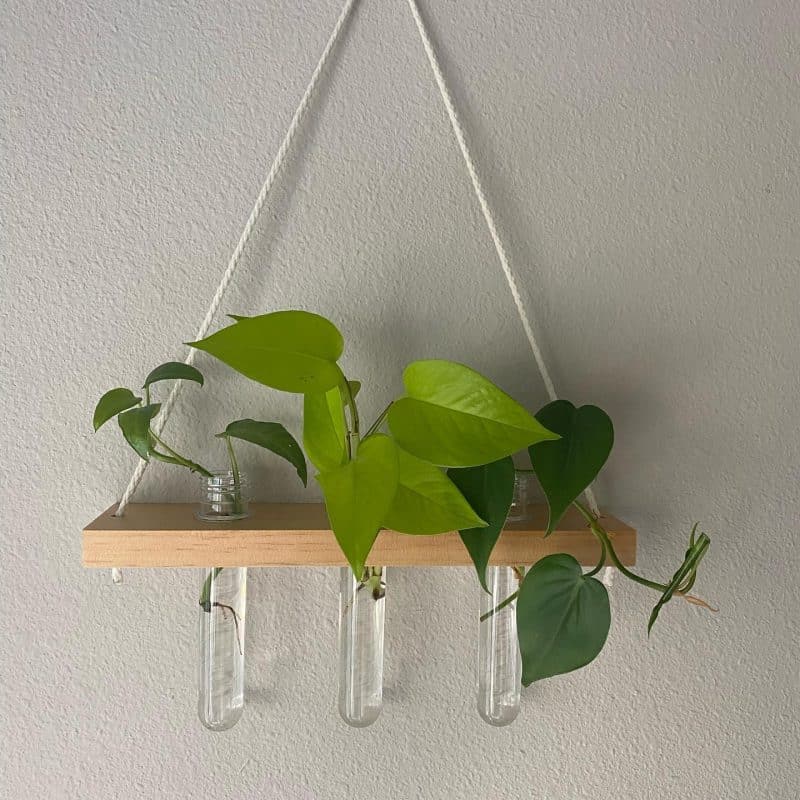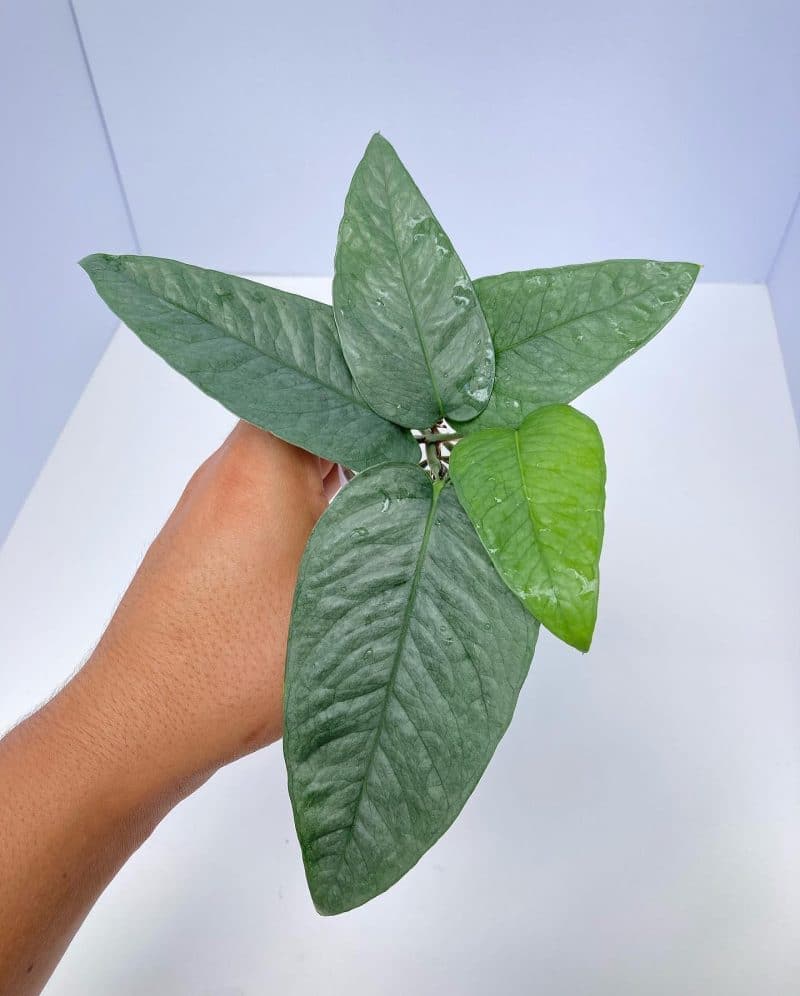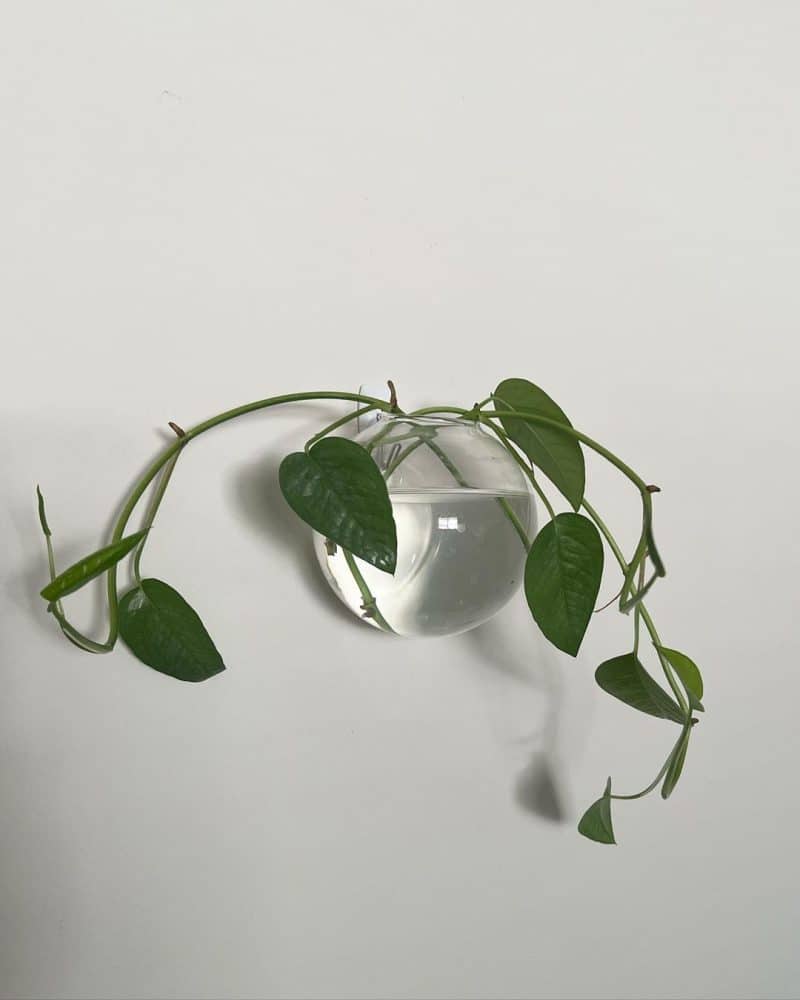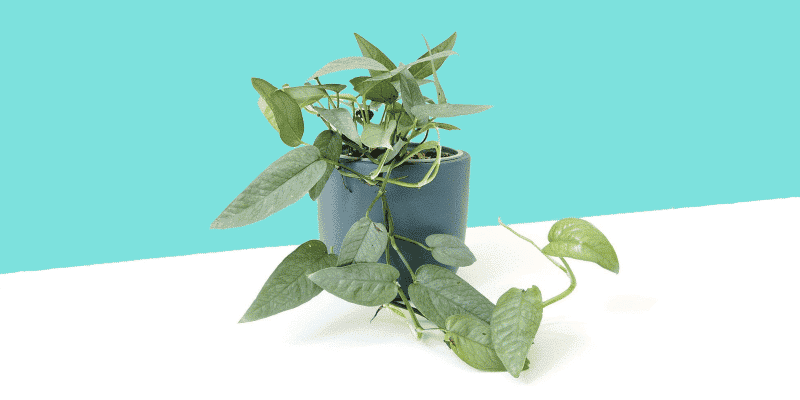Do you have a brown thumb? Maybe a blue-ish silver one?
Well, I have the perfect plant for you. The Cebu blue pothos is an easy-to-care-for indoor plant that will make your friends green (with envy).
The Cebu blue pothos is an evergreen vine with beautiful, blue-green leaves. And it’s only becoming more and more popular as a houseplant.
The only tricky thing about this plant is that it has two distinct growth phases: juvenile and mature (with fenestrations).
We’ll cover both growth phases in this article, along with a care guide, how to deal with the most common issues that come up, and how to propagate your Cebu blue pothos.
(This plant loves to grow up a moss pole, so we’ll cover that, too!)
Table of Contents
Cebu Blue Pothos Care Guide
History, habitat, and characteristics

The Cebu blue pothos (also known as Epipremnum pinnatum ‘Cebu Blue’) originally gets its name from Cebu Island in the Philippines, where it naturally occurs as an outdoor plant.
More recently though, the Cebu blue pothos has become a popular houseplant throughout the United States due to being easy to care for, easy to find in gardening centers, and its unique silver-blue-green leaves.
The Cebu blue pothos is part of the Araceae family, which contains more than 100 genera and 3,600 species of flowering plants. It looks very similar to Epipremnum pinnatum (dragon tail plant or tibatib), so don’t be fooled.
As a variety of the common pothos (Epipremnum aureum), also known as “devil’s ivy,” the Cebu blue pothos can reach lengths of over 8 feet indoors (on a pole) or over 20 feet in its natural outdoor habitat.
This plant experiences two distinct growth phrases: juvenile and mature. We’ll get into both of these a bit later in more detail, but most commonly you’ll be dealing with the juvenile phase indoors.
If you’ve seen pictures of the Cebu blue pothos on Instagram or FB, this is the phase you’re most likely seeing. It’s marked by its characteristic blue-green leaves, which vary in finish between silvery-matte and glossy-green as the leaves mature.
How does the Cebu blue pothos get its rare color?

Blue is a very rare color to see in nature, even an attenuated blue as found in this plant. The reason is there isn’t a naturally occurring blue pigment in plants (or animals for that matter).
Instead, the blue color is structural. This means that it’s not produced by a pigment, but rather by the way light interacts with the cell structure in the leaves.
According to Simon Queenborough in the Annals of Botany, many tropical plants protect themselves using something called delayed greening which postpones the full production of chlorophyll to protect younger plants from UV damage or insects looking for a snack.
By slowing down the growth process of the Cebu blue pothos, the plant in nature can develop and mature a bit more slowly, but with fewer threats. By the time it reaches its mature growth phase, it’s able to better defend itself from predators with naturally occurring compounds and its leaves increase chlorophyll production, increasing the rate of growth in the plant.
Light
To encourage healthy plant growth, the Cebu blue pothos loves a spot that provides medium-to-bright indirect light. Unlike other pothos, this plant doesn’t do great in low light for very long.
You’ll also want to avoid the direct sun, especially with a young plant as it doesn’t yet have enough chorophyll to make use of that energy.
Cebu blue plants are a lot easier to take care of than other related indoor plants because you don’t need to manage their variegation (like say the Silver Satin or Manjula pothos). With variegated plants even too much indirect sunlight can cause their leaves to turn completely green, but both dislike direct sunlight.
Water
Watering a Cebu blue pothos is pretty straightforward, but let’s break watering down into the few variables we need to keep track of.
Frequency of watering. This is how often you’re going to water the plant. Each climate will have different requirements, but the way to figure out when it’s time to water again is to touch the top two inches of the soil. If they’re dry to the touch, it’s time to water.
Amount of water. The second variable is how much water you’re going to give the plant when you do water it. Again, super easy. You’ll be using a pot with drainage holes in the bottom, so water it thoroughly until you see water draining from the bottom. You don’t need to add so much water that the plant wants to float away, so aim for soil that’s evenly moist but not too soggy.
If you start seeing yellow leaves (which we’ll cover more later in depth), you might be overwatering the plant (check for moist soil) and weakening its root structure.
Temperature and humidity
Even though the Cebu blue pothos is happy at home in a tropical climate like the Philippines, it has a wide range of growth conditions, making it an easy houseplant to take care of.
Let’s explore the temperature/humidity that this plant prefers:
Temperature: The Cebu blue pothos prefers normal indoor temperatures, from 65-78 degrees Fahrenheit. If you shock it with a temperature much colder than this, you’ll likely discover some wilting leaves within a day or two.
Humidity: The Cebu blue plant prefers a humidity level of around 50%. If you don’t have a way of measuring your humidity, you can suspect it might be too low if the leaves turn brown or start curling up at the edge. Too high? You’ll see mold growing in the soil and up the leaves.
If you are noticing the humidity levels are a bit low, here are a few ways you can increase the moisture for your plant:
- Pebble tray. Place clean pebbles (rocks from the garden work fine) in a tray and fill the tray with water so the pebbles are sitting in the water. Place your pot on top of the pebbles. As the water evaporates, the humidity around your plant will increase. You can expect to see around a 5-6% increase in humidity from this technique.
- Misting. You can also try misting your Cebu blue pothos with distilled water to increase the local humidity. Be sure to do this in the morning so the leaves have time to dry under bright indirect sunlight.
- Humidifier. If you have other houseplants, you might already have a humidifier. If not, consider the cost because they’ll help increase the humidity for all your plants, not just the Cebu blue pothos.
- Clustering with other plants. Placing your Cebu blue pothos with other plants will increase the humidity because all the plants are transpiring (releasing water vapor through their stomata) together. It also slows down the rate of evaporation and mimics the natural humidity barrier of a jungle canopy.
So why does humidity matter?
Controlling humidity for a tropical indoor plant like the Cebu blue pothos is essential for two main reasons:
- first is to allow for temperature regulation (just like how we sweat), when humidity is high, it can hold less water, meaning they lose their water less quickly and stay warmer;
- second is to ensure healthy growth. When humidity is low, plants close their stomata which controls not just how quickly they lose water but also affects the amount of carbon dioxide and oxygen leaves can exchange, slowing down the growth of the plant, too.
So if your plant growth has slowed down, and leaves don’t appear as healthy as when you got the plant, make sure to grab a humidity meter and take a peek.
Soil, planting, and repotting
Cebu blue pothos plants (like other varieties of pothos plants) do best in a well-draining soil mix.
As this is an easy plant, you can use a bagged potting mix that you’d find at the store, but I also recommend adding one of the following:
- orchid bark
- perlite
- LECA
Remember, whichever potting soil you use you’ll want it to drain easily (you should be able to visually see that as you water it).
Cebu blue pothos also tends to become root bound (like many other tropical vines). You’ll notice this if you seem to be doing everything right but growth has stopped, leaves are wilting and yellowing, and water is draining more slowly.
To fix this, unpot the plant to confirm it’s pot bound, step up your existing pot by a few inches, and then repot, making sure to include one of the following ingredients above to promote airiness.
Fertilizer
Cebu blue pothos does well with fertilizer during the growing season (spring and summer), but if you’re using a potting mix you bought from the store make sure it doesn’t have added fertilizer.
I prefer using neutral soil and then I add a balanced liquid fertilizer once every 4-6 weeks. If you’re looking for slower growth, you can dilute the dose or use compost tea.
Growth phases
As we mentioned, the Cebu blue pothos has two distinct growth phases: the juvenile and mature phases.
The juvenile phase is what you’ll likely see indoors, where it grows horizontally, with longer internodes (the spacing between two leaves/buds), and the plant will tend to look more “leggy” or stretched out.
The mature phase (which is typically only seen outdoors or in an indoor botanical garden) is marked by leaves that have begun to fenestrate and have high vertical growth.
So why do the Cebu blue pothos leaves fenestrate? Is there an evolutionary purpose?
We’re not sure, but according to Christopher D. Muir in The American Naturalist, adaptive leaf morphology might protect a maturing plant from changing conditions, making it so that its leaves have a lower chance of breaking off or tearing in a tropical, windy climate.
It’s also possible that these small holes/divisions affect how rain propagates down the plant into the root structure, or how reliably the plant can grow and take in direct sunlight.
Cebu blue pothos propagation guide

You have a few options when propagating Cebu blue pothos. I’ll quickly cover two of my favorite: water propagation and sphagnum moss propagation. The steps are very similar, only the medium differs.
For water propagation, follow these steps:
- Fill a clean jar or glass with distilled or filtered water (I’ve found that plants just seem to do better with non-tap water).
- Cut a 6-8 inch section from the base of your Cebu blue pothos plant, making sure to include at least 5 leaves.
- Remove the bottom leaves so that only 2-3 leaves are left on the cutting.
- Place your stem cuttings in the water.
- Change out the water every few days, and in a few weeks, you should see roots growing!
With water propagations, I recommend avoiding bright light as this can lead to fungus/algae growth in the water.
For sphagnum moss propagation:
- Soak your moss in water for 20 minutes, and set it aside as you go through the rest of the steps.
- Just like water propagation, take a few stem cuttings from your plant with at least 5+ leaves each.
- Remove the bottom leaves so you’re left with 2-3 leaf nodes fully exposed where cut.
- Dip the cut end of each stem node in rooting hormone (Optional).
- Squeeze the water out of your moss, placing it in any small container (I prefer clear so you can keep track of the root growth).
- Take your stems and plant them in the sphagnum moss, making sure any exposed nodes are fully planted in the moss.
- In around 3-4 weeks you should see root growth, and when they reach 2 inches long you can transfer your cuttings to potting soil.
Moss propagations should be kept in the most humid spot in your house (likely your bathroom, is if gets window light), but there’s another trick I have for you. Ever get potatoes from the grocery store and forget to take them out of a plastic bag? It gets humid, moist, terrible for potatoes.
Great for moss propgations.
Wrap the lower half of your pot with a clear plastic bag and watch those roots come in!
Common Cebu blue pothos care issues
If you’re just getting started with indoor plants, there’s a lot to keep track of. Just when you notice one issue or variable, another pops up and you start making more and more adjustments.
My advice: just change one thing at a time. We’ll cover the most common issue that come up, and don’t worry: they’re common for a reason.
Yellow leaves. Likely due to too much sun exposure or not enough water. Yellowing leaves can also be a sign of nutrient deficiency, so be sure to fertilize your plant. If the leaves are crispy around the edges, cut back the light. If the soil stays moist, try letting it go a bit longer.
Wilting leaves. This is usually a sign of too little water, especially if they feel weak and thin. If you’re losing large clumps and they’re getting dark quickly, it could be temperature shock or too much water.
Brown leaves. Your first thought when you see crispy, browning leaves is too much fertilizer or too much direct light. If instead, you’re noticing brown spots on the leaves, it’s likely due to a pest (see our section below).
Slow growth. If your Cebu Blue Pothos is growing slowly it’s likely due to too little light, not enough water, low humidity, or poor drainage. I know, a lot of variables here. I’d adjust humidity first, and then light.
Diseases and pests
If your plant is healthy and doing well, you shouldn’t have any issues with diseases or pests. These often start cropping up from a damaged plant (too much sunlight, too much water) that’s weakened and vulnerable to pests or rot.
Commonly we’ll see one of the following:
Root rot. This is very common in plants that are overwatered or that have soil that’s not well-draining. It can be confirmed by removing your plant from the pot and visually inspecting the roots. If you do see wet slimy roots, you have root rot. Cut off the affected part of the plant and then repot it in fresh soil. Make sure the drainage hole is well-sized so that excess water can run off.
Spider mites or other bugs. If you notice webbing or brown spots on your leaves, this is a sign that you might have an insect problem. Take a look at the underside, soil, and stem for any signs of mites. Isolate the plant, physically remove any mites you can with a water rinse, then apply soapy water to discourage future growth. Some people just prefer to use a neem oil spray, this also works well.
Conclusion
The Cebu blue pothos is an easy-to-care-for houseplant with wonderful silvery-blue leaves and two unique growth phases. Like other pothos plants, it does well in a variety of climates outside of its natural habitat and can make any room start to feel like an indoor jungle.
Cebu blue pothos care summary:
- Water every 7-10 days in well-draining soil or the top inch or two is dry;
- Place 2-4 feet from a window with bright, indirect light;
- Keep above 50% humidity if at all possible;
- Vor vertical growth, use a moss pole;
If you find this article helpful, consider sharing it with a friend who might want to grow their own Cebu blue pothos (or heck, send them one of your propagations!). If you have any suggestions or questions, feel free to get in touch on Instagram or Twitter!
FAQ
Do Cebu blue pothos leaves produce fenestrations?
Yes, they do in the mature growth phase. When allowed to climb, this plant will develop split leaves (or fenestrations) similar to a monstera or fern. In fact, all pothos plants do this!
How can you tell if you have a mature Cebu blue plant?
Three ways: height, leaf fenestration, and leaf color. As the plant matures its leaves will become a glossier green as they fill with chlorophyll.
Do Cebu blue pothos climb?
Absolutely! They climb great along a moss pole but keep in mind they’ll also grow in weight and these plants can reach over 8 feet indoors, so give them the proper support (both physical and nutrition).
Is Cebu blue pothos rare?
They once were considered rare but now are readily available in North America, you can find them on Etsy or most garden supply stores.
Is Cebu blue a true pothos or a philodendron?
Cebu blue is a pothos! They both belong to the same family (Araceae) but different genera (Epipremnum and Philodendron). Pothos plants typically have a thicker, waxy leaf while a Philodendron features more symmetrical, smooth leaves.


